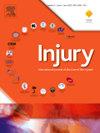Decrease in pediatric farm-related injuries presenting to United States emergency departments: A national study from 2014-2023
IF 2.2
3区 医学
Q3 CRITICAL CARE MEDICINE
Injury-International Journal of the Care of the Injured
Pub Date : 2025-03-22
DOI:10.1016/j.injury.2025.112299
引用次数: 0
Abstract
Introduction
Pediatric farm-related injuries, while less common than other pediatric injuries, are often more severe. Agricultural youth injuries can require costly treatment and have higher hospitalization rates, often resulting from industrial hazards, unsafe worksites, or agricultural recreational activities. Injuries in rural areas often necessitate travel to larger hospitals for specialized treatment, delaying care.
Objective
This study aims to evaluate trends in farm-related injuries among youth presenting to emergency departments (EDs) in the United States (US).
Methods
The National Electronic Injury Surveillance System (NEISS), a publicly available database representing approximately 100 US EDs, was queried for all injuries among individuals aged 0–18 occurring in farms (land, pasture, farm, barn, outbuildings). Queries were restricted to injuries from 2014 to 2023.
Results
From 2014 to 2023, a total of 750 ED visits from farm-related injuries were identified, resulting in a national estimate (NE) of 33,664 cases. Injury rates decreased significantly across the study period (P=0.012). The most common diagnosis was fracture (NE 7337, 21.8 % of all injuries), with males accounting for 52.1 % and females for 47.9 %. In an age-specific analysis, 12-year-olds experienced more farm-related injuries than any other age group (NE 3185, 9.5 %), followed by 11-year-olds (NE 2769, 8.2 %), who also sustained the highest number of head injuries (NE 711, 13.2 % of all head injuries). The most commonly affected body part across ages was the head (NE 5384, 16 % of all injuries). The most common mechanism of injury was horseback riding (NE 10,691, 31.8 % of all injuries). The overall rate of hospitalization was 13.5 %.
Conclusion
The incidence of farm-related injuries in young people has decreased over time. Most injuries are caused by horseback riding, with a majority involving the head and relatively high hospitalization rates. 11–12-year-olds are the most affected, highlighting the importance of continued targeted prevention efforts. Although occupational hazards are a concern, this study demonstrates that younger patients are also frequently affected by farm injuries, emphasizing the need for increased focus on child access and safety in agricultural recreational activities.
求助全文
约1分钟内获得全文
求助全文
来源期刊
CiteScore
4.00
自引率
8.00%
发文量
699
审稿时长
96 days
期刊介绍:
Injury was founded in 1969 and is an international journal dealing with all aspects of trauma care and accident surgery. Our primary aim is to facilitate the exchange of ideas, techniques and information among all members of the trauma team.

 求助内容:
求助内容: 应助结果提醒方式:
应助结果提醒方式:


